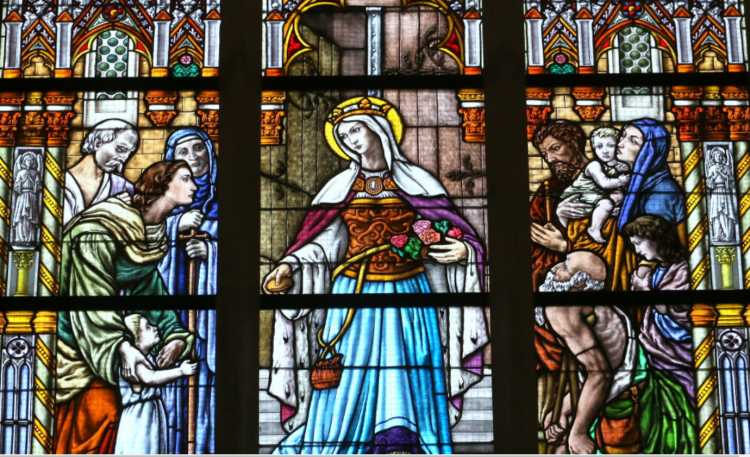
The rose miracle

Budapest, the capital city of Hungary, was created in 1873 by the merger of three settlements, Buda, Óbuda and Pest. One of its then ten districts, the today’s Elisabeth District, had been named after Elizabeth, the Queen of Hungary and wife of Emperor Francis Joseph I. Before constructing the Grand Boulevard, or as it is informally known ‘Nagykörút’ on the city’s Pest side, Dob and Dohány streets were the main district roads of the 19th century. This was the time when the territory of the present Rózsák Square and its surroundings, the so-called Beast market area, had been opened up for parcelling. Buildings sprang up one after the other, like the National Protestant Orphanage, the Training Institution for Kindergarten teachers of the National Nursery School Association, and the Elisabeth Care House of the Poor, upon which the square was renamed to Poor House Square.
Teaming up and building a church
Given the mergers of several districts, and their accelerated development, the number of Catholic believers sharply increased in the Elisabeth District, thereby giving an impetus for constructing a new parish church. Upon the cooperation between Cardinal János Simor, Prince Primate and the management of the capital, an independent parish was established. A smaller church with a capacity of 400 was built according to the design of architect Győző Cziegler, and was consecrated in November 1881. In parallel, preparations for a gigantic construction began.
Cornerstone laying in the presence of the King
János Simor, Prince Primate purchased the property of the present Rózsák Square with the purpose to build a church. A tender had been announced, for which six architects submitted their architectural plans. Finally the jury voted for the design of Imre Steindl, Professor at the Budapest Technical University. The construction works were already in full swing, when the cornerstone laying ceremony was organised and held in the presence of Francis Joseph I. On account of a significant time lag in the works, the consecration could not take place in the year of the Millennium. Later on the assassination against Queen Elizabeth delayed the church opening. The exterior works had been completed by the end of 1897, then the interior designing became the next step. Each of the two spires rise into the air at a height of 76 metres. The church covers a 1,800 square metres surface while the capacity amounts up to 2,600.

The birth of the Steindl “paste”
Architect Imre Steindl’s architectural plan grounded on adapting the traditions of the French Gothic architecture, and fusing it into modern technical solutions. The characteristics feature a cross-shaped 3 nave and a transept form, while the main entrance has been placed between the two towers. Statues that are set around the niches of the pointed arch shaped facade are the works of sculptor Miklós Köllő, figuring St. Ladislaus I of Hungary, Virgin Mary and St. Stephen. The architect followed the traditional Gothic style cruciform building. The long main nave has six aisles upto the transept, while the hexagonal sanctuary and the two octagonal stair towers make the entire structure even more thrilling. The church walls are covered with yellow pressed bricks, however carved natural stones were also used. The terracotta works were manufactured in the factory of Vilmos Zsolnay at Pécs, who, together with Imre Steindl developed new materials that were based on the originally called Steindl “paste” and later became known as pyrogranite.

Miksa Róth’s stained glass windows
The inside layout of the church fits the puritan lifestyle of its namesake. The stained glass windows of the main nave were destroyed during the 2nd World War. The pulpit, decorated with the reliefs of the four evangelists, was manufactured in Sándor Hauszmann’s workshop. The gilded wooden side altars of the transepts are the masterpieces of Mór Holtz, while its paintings with biblical sceneries and saints are the paintings of Gyula Aggházy and Lóránt Zubriczky. In the chapels set between the transepts and the sanctuary, as well as under the stair towers, altars are placed, the statues of which are the works of the sculptors Ede Mayer and Mikós Köllő. The main nave is divided from the sanctuary by a sacrificial grid. The main altar is made of marble, onyx and bronze, while a gilded tabernacle that stands on top are Lajos Lantay’s works depicting Hungarian Saints and Blessed ones. Two sacristies open from the sanctuary with oratorios above them. Miksa Róth’s wonderful stained glass windows embellish the sanctuary. Originally the church had four towers, but 2 of them were requisitioned for military purposes during the 2nd World War.
On the knees
Faithful had to wait for the church consecration until 1901. According to the reports of the time, Emperor Francis Joseph, King of Hungary was on his knees all along the Holy Mass on a stool set up for him. “They were singing the Hungarian royal anthem as well, the lyrics of which were written by Jókai –who was also present-, while the melody was composed by Ferencz Erkel. This was played and sung when the King entered and left the church. His Majesty once again glanced at the church from the lounge, made his compliments and asked questions to many.”
The smaller church that had been in use for more than thirty years, was gifted in 1905 to the Greek Catholic Church and operates alike under the name of Our Lady of the Virgin Mary.

A remembrance of St. Elisabeth of Hungary
Upon the faithful’s initiative a statue had been erected in 1931 in front of the church to commemorate the 700th anniversary of the death of St. Elisabeth of Hungary. At the same time the square itself has been renamed Rózsák (Roses) Square after the Hungarian Saint’s attribute, the rose. The full body, standing sculpture is the work of sculptor József Dankó. The pedestal of the statue is embellished by sceneries from the life of St. Elisabeth. On one side the Saint takes over the belt of the Franciscan order, while the other side shows her giving drinks to the poor. During the 2nd World War a bomb hit the square, and during the lengthy siege of Budapest many hits demolished the church. The roof, the statue of St. Elisabeth, the spires and even the organ were seriously damaged. During the socialist dictatorship no reconstruction works were carried out on the church, therefore its condition further deteriorated.
One of the venues of the Eucharistic Congress
The Foundation for St. Elizabeth Parish Church, founded in 1992, undertook the organisation of reconstructing the church. Step by step the amazing building has gone through a renewal. The glass windows of the sanctuary that remained more or less intact, depict Hungarian Saints, and the same theme has been continued on the new windows of the aisles. A place has been given among the saints for St. Ladislaus’ daughter, St. Irene of Hungary, later on, the Byzantine Empress, always having been highly respected in the Greek Orthodox Church. Amongst the 20th century prominent persons, the figures of Vilmos Apor and Mother Teresa of Calcutta are also appearing on the windows.
The marvellous church that is referred to by many as one of the most beautiful ones of Budapest is going to serve an important role in the 52nd International Eucharistic Congress. On the 8th September, at 17.00, Archbishop of Jérôme Beau will celebrate a Parish Mass in French. The same day will be presented the Oscar nominated “Budapest Mass”, composed by Péter Pejtsik, the composer having been involved in the re-orchestration of the IEC’s anthem as well.

Photo: esztergomi-ersekseg.hu










